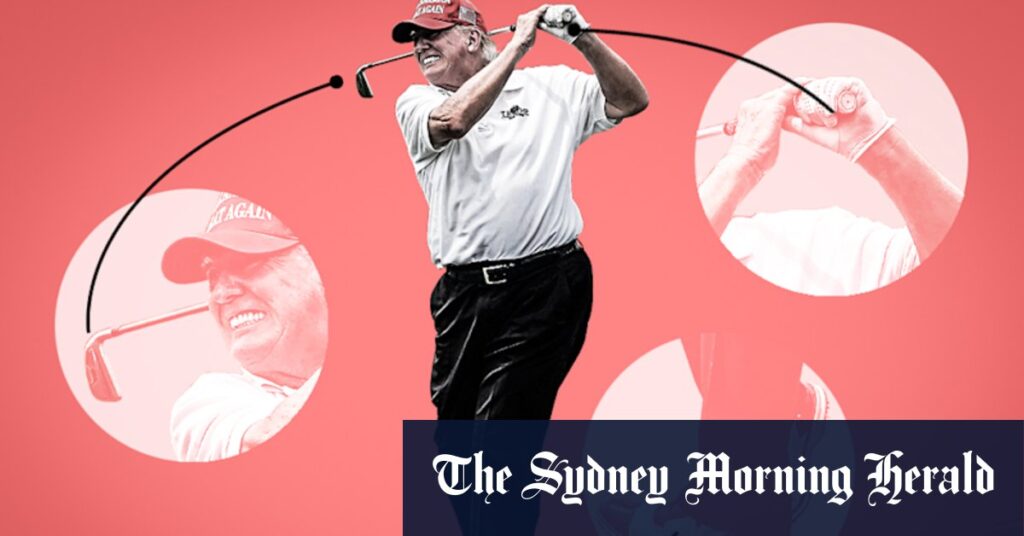Days after announcing tariffs that sent shockwaves around the world last week, US President Donald Trump spent the weekend golfing in Florida. As trillions of dollars were wiped off global markets, including 6 per cent from the Australian sharemarket at the opening bell on Monday, Trump strolled along in shoes – and used equipment – manufactured outside the US.
While Trump argues the tariffs are necessary to revive American manufacturing and reduce the country’s trade deficit – which reflects the value of its exports minus the sum of its imports – his solution will drive up prices.
For Trump, that includes the cost of much of his prized golfing collection. Even where parts of it are assembled or made in the United States, raw materials or components from overseas will be affected by tariffs and push up the price.
Trump is not shy about his love of golf, turning his rounds – including some with celebrities such as American major winner Bryson DeChambeau – into photo opportunities and allowing this masthead to analyse the origins of his gear.
Driving up costs
While TaylorMade, the maker of Trump’s driver and irons, is based in California, some of the materials and parts it uses are sourced from countries scheduled to face major tariffs according to All American, a manufacturing analysis site.
The TaylorMade website is largely silent on the origins of key components for its products but parts for a significant share of its products originate from countries including China and Vietnam, according to maps of its suppliers.
Loading
Trump’s TaylorMade Qi10 Max driver, for example, is made up of pieces manufactured in China, which are then shipped to the US and assembled in California. China, as a major manufacturing hub, also makes its own golf clubs, and is among the top exporters of golf clubs alongside Mexico and Japan.
Slapping a tariff on imports, including a 54 per cent tariff on Chinese goods, means Donald Trump will drive up the price of the parts used to make his favourite driver and irons.
Clubs are a globalised product
Like TaylorMade, Titleist – the maker of Trump’s wedges and golf balls – leans on Chinese manufacturing.
The head of his Titleist Vokey wedges for example, was likely made in China or Vietnam, according to markings on many of the clubs, before being assembled in the US.
Vietnam, with its low production and labour costs, has become one of the world’s major manufacturing hubs, and a major producer of golf equipment. Its growth as a manufacturing nation has been driven in part by US tariffs on China under the previous Trump and Biden administration that spurred Chinese companies to shift investment to their southern neighbour.
Titleist golf balls, however, have been manufactured in Massachusetts for more than 80 years.
Nonetheless, Trump’s wedges will likely face the same fate as much of his other equipment after he slapped one of the biggest tariffs, at 46 per cent, on imports from Vietnam. The country has offered to remove all of its tariffs on US goods if Trump does the same for Vietnam.
A US manufacturer that offshored jobs is a Trump favourite
FootJoy, the footwear brand worn by Trump on his latest golf adventure, is an American company specialising in golf shoes.
Founded in Brockton, Massachusetts, FootJoy used to manufacture its golf shoes in the US. But in 2009, around the same time China surpassed the US as the world’s largest manufacturing nation, the company closed its Brockton facility and now makes its products in China.
More than half of the footwear worn worldwide is produced in China, where relatively low labour costs make production cheaper than in countries such as the US. In 2021, the US imported nearly US$11.5 billion ($19.1 billion) worth of footwear products from China. China also benefits from networks of factories that supply each other with components and a skilled manufacturing workforce that can rapidly improve products and create prototypes for new designs.
Putting pressure on steel prices
Scotty Cameron, a golf club manufacturer behind Trump’s Newport putter, makes its products in the United States.
Its website says every putter produced has been designed, milled and built in the United States, with the hefty price tag on its putters likely reflecting the higher costs associated with manufacturing domestically.
While the US produces 303 stainless steel (the material used to make Scotty Cameron putters) the country also imports steel from countries such as China, Germany and Japan, meaning it is possible that even this piece of golf equipment will become pricier for Trump.
Loading
Even if Scotty Cameron uses only domestically produced steel, the tariffs could put upward pressure on US steel prices as competition grows for the tariff-free product in the short term.
And to cap it all off…
Trump’s golfing get-up would not be complete without his “Make America Great Again” cap.
New Jersey-based clothing wholesaler Unionwear made the original MAGA hats for his 2016 campaign, but it is not clear where newer hats are manufactured or where the materials are sourced from.
Cut through the noise of federal politics with news, views and expert analysis. Subscribers can sign up to our weekly Inside Politics newsletter.


